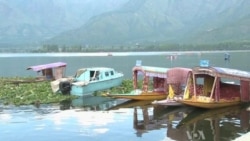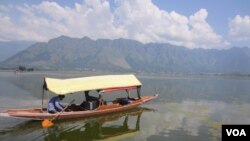SRINAGAR, INDIAN-KASHMIR —
Many Kashmiris can remember when calm returned to the Himalayan region following nearly two decades of insurgent violence.
Militant attacks dropped after India and Pakistan signed a 2003 cease-fire deal, transforming Indian-controlled Kashmir’s economy. Gulzar Beigh stopped working as a laborer and instead rented a boat, or “shikara,” to ferry a new surge of visitors to the valley. He made an average of $250 a month last year.
“Tourism really improved here in the last eight years. The number of tourists increased,” Beigh said as he paddled his shikara across Dal Lake. “My friends and neighbors are all involved in the industry, some sell jewelry, some sell shawls.”
In Srinagar, travel agency and restaurant owner Kaiser Bhat says the city almost transformed overnight. As violence subsided, religious pilgrims and tourists flocked to what many call the Switzerland of South Asia. Bhat recalls how in 2006, as new hotels and houseboats sprung up, they were quickly overbooked.
“You won’t believe it but there were people who literally slept on this road because after so long Kashmir became open,” Bhat said, pointing to the street that encircles Dal Lake. “There were people who had not been to Kashmir for the last 20 to 25 years.”
Headlines affecting tourism
While Kashmir’s tourism industry has seen a boom in the last few years, attracting as many as 1.2 million visitors to the region, locals say it only takes one attack or the threat of violence to scare people away.
Bhat’s restaurant, Kareem’s, is just meters away from Dal Lake’s waterfront. He says during the peak tourist month of May, people have a tough time getting a table. On this day, only one other person, a foreigner, is enjoying the restaurant’s Kashmiri specialties.
Outside, the sidewalks surrounding Dal Lake are mostly empty along with the many hundreds of houseboats that should be packed with Indian and foreign tourists.
Houseboat Owners Association head Azim Tuman says Indian Kashmir was set for another great year with tourists who booked their trip to the region early. Then in February, convicted Indian parliament attacker and Kashmiri native Afzal Guru was hanged. Tuman says many tourists cancelled their plans, fearing violent protests.
“There was some stone-pelting because people were angry. That step was taken in haste and at a wrong time, because it was the beginning of our tulip season, when we expected a lot of tourists to visit Kashmir,” said Tuman.
Unlike many other Indian cities that come to life once night falls, Srinagar is quiet, with many stores closing in the early evening hours even when no curfew is in force.
Inside his shop, Amir Hussain folds the embroidered shawls and gets ready to pack up after another lackluster day of sales. His business has seen far fewer customers since Afzal Guru’s execution. Hussain says visitors are also scared away by the sporadic cross-border shootings that draw headlines, but happen far from the main town.
“They [the government] can speak out and tell people that wherever the unrest is happening is 1,200 kilometers or very far from Srinagar to reassure them that there is no problem and that they can safely visit,” he said.
Getting the word out
In fact, many of the tour operators and hotel owners say the government should do more to encourage tourists to visit Indian-controlled Kashmir.
Kaiser Bhat says attracting visitors mainly falls on the shoulders of the tour operators and others in the industry. He says he has traveled throughout India and to Southeast Asia to spread the word about the Himalayan region and reassure potential visitors who may have safety concerns.
“If people come to Kashmir, it’s 90 percent effort of the people who are related to tourism, rather than the government,” he says.
Bhat says the area is not properly promoted. The travel agency owner cites the example of the 18-hole Royal Springs Golf Course overlooking Dal Lake, often called one of the most picturesque in Asia. He says the government should be offering packages for the public golf course and working to ensure early morning and late night flights are available for golfers flying in and out of Srinagar.
Back on Dal Lake, boatman Gulzar Beigh says he is optimistic that increased stability will mean more visitors taking in the Himalayan mountains that grace the valley.
“If it stays peaceful here, then the world famous place of Kashmir will be popular again,” said Beigh. "We all hope, including visitors who come here, that Kashmir will become a peaceful place.”
Photo Gallery:
Militant attacks dropped after India and Pakistan signed a 2003 cease-fire deal, transforming Indian-controlled Kashmir’s economy. Gulzar Beigh stopped working as a laborer and instead rented a boat, or “shikara,” to ferry a new surge of visitors to the valley. He made an average of $250 a month last year.
“Tourism really improved here in the last eight years. The number of tourists increased,” Beigh said as he paddled his shikara across Dal Lake. “My friends and neighbors are all involved in the industry, some sell jewelry, some sell shawls.”
In Srinagar, travel agency and restaurant owner Kaiser Bhat says the city almost transformed overnight. As violence subsided, religious pilgrims and tourists flocked to what many call the Switzerland of South Asia. Bhat recalls how in 2006, as new hotels and houseboats sprung up, they were quickly overbooked.
“You won’t believe it but there were people who literally slept on this road because after so long Kashmir became open,” Bhat said, pointing to the street that encircles Dal Lake. “There were people who had not been to Kashmir for the last 20 to 25 years.”
Headlines affecting tourism
While Kashmir’s tourism industry has seen a boom in the last few years, attracting as many as 1.2 million visitors to the region, locals say it only takes one attack or the threat of violence to scare people away.
Bhat’s restaurant, Kareem’s, is just meters away from Dal Lake’s waterfront. He says during the peak tourist month of May, people have a tough time getting a table. On this day, only one other person, a foreigner, is enjoying the restaurant’s Kashmiri specialties.
Outside, the sidewalks surrounding Dal Lake are mostly empty along with the many hundreds of houseboats that should be packed with Indian and foreign tourists.
Houseboat Owners Association head Azim Tuman says Indian Kashmir was set for another great year with tourists who booked their trip to the region early. Then in February, convicted Indian parliament attacker and Kashmiri native Afzal Guru was hanged. Tuman says many tourists cancelled their plans, fearing violent protests.
“There was some stone-pelting because people were angry. That step was taken in haste and at a wrong time, because it was the beginning of our tulip season, when we expected a lot of tourists to visit Kashmir,” said Tuman.
Unlike many other Indian cities that come to life once night falls, Srinagar is quiet, with many stores closing in the early evening hours even when no curfew is in force.
Inside his shop, Amir Hussain folds the embroidered shawls and gets ready to pack up after another lackluster day of sales. His business has seen far fewer customers since Afzal Guru’s execution. Hussain says visitors are also scared away by the sporadic cross-border shootings that draw headlines, but happen far from the main town.
“They [the government] can speak out and tell people that wherever the unrest is happening is 1,200 kilometers or very far from Srinagar to reassure them that there is no problem and that they can safely visit,” he said.
Getting the word out
In fact, many of the tour operators and hotel owners say the government should do more to encourage tourists to visit Indian-controlled Kashmir.
Kaiser Bhat says attracting visitors mainly falls on the shoulders of the tour operators and others in the industry. He says he has traveled throughout India and to Southeast Asia to spread the word about the Himalayan region and reassure potential visitors who may have safety concerns.
“If people come to Kashmir, it’s 90 percent effort of the people who are related to tourism, rather than the government,” he says.
Bhat says the area is not properly promoted. The travel agency owner cites the example of the 18-hole Royal Springs Golf Course overlooking Dal Lake, often called one of the most picturesque in Asia. He says the government should be offering packages for the public golf course and working to ensure early morning and late night flights are available for golfers flying in and out of Srinagar.
Back on Dal Lake, boatman Gulzar Beigh says he is optimistic that increased stability will mean more visitors taking in the Himalayan mountains that grace the valley.
“If it stays peaceful here, then the world famous place of Kashmir will be popular again,” said Beigh. "We all hope, including visitors who come here, that Kashmir will become a peaceful place.”
Photo Gallery:










